 |
 |
|
|
Icon, "MOTHER OF GOD OF CHERNIGOV", Russia
"MOTHER OF GOD OF CHERNIGOV", end of the 19th century, Russia, grafija, tempera on wood, 22,3x17,6x2,1 cm
|
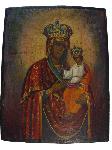
|
| : 6800 |
ID: 6085 | |
 |
| |
Icon, “THE VIRGIN OF TIKHVIN AND MOTHER OF GOD “LIFE-GIVING SPRING, above JESUS THE PANTOCRATOR”, Russia
“THE VIRGIN OF TIKHVIN AND MOTHER OF GOD “LIFE-GIVING SPRING, above JESUS THE PANTOCRATOR”, the 19th century, tempera, oil on wood, gold sheet, 110x91x2,7 cm In picture “Life-giving Spring” is depicted an enormous stone chalice, standing in a wide reservoir, arms the Infant Jesus, hovers the Most Holy Virgin. To the reservoir filled with life-giving water have streamed those who thirst. The unfortunate and life-weary drink of the water and become strong and invigorated
|
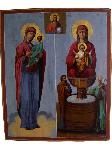
|
| : 100000 |
ID: 6084 | |
 |
| |
Icon "ENTHORNED CHRIST AND SELECTED SAINTS", Russia
"ENTHORNED CHRIST AND SELECTED SAINTS: Martyr Sophia, Apostle Markus, Apostle Jakov, Apostle Andrew, Apostle John, Apostle Pavel, Virgin Mary, Nicholas the Thaumaturgos, Andrew, Basil, Basil the Great, Georgy the Thologian, John the Chrysostom, John the Baptist, Apostle Mattew, Antipa, Zosima, Sabbatius and two Angels", 19/20th century, very fine painting, (Moscow?)grafija, gold, tempera on wood (cypress), golden assist, 35,5x30,7x1,5 cm
|

|
| : 36000 |
ID: 5249 | |
 |
| |
Icon "ST CHARLAMPUS AND ST BLAISE", Russia
"ST CHARLAMPUS AND ST BLAISE", second half of the 19th century, tempera, oil on wood 29,5x25,2x2,6 cm
|
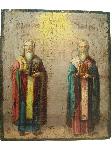
|
| : 8000 |
ID: 5246 | |
 |
| |
Icon “THE ANNUNCIATION OF VIRGIN MARY”, Russia
“THE ANNUNCIATION OF VIRGIN MARY”, begin of the 19 century, oil on canvas, school of province, Russia, 178x111x3 cm
|
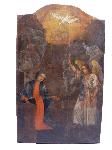
|
| : 61000 |
ID: 5241 | |
 |
| |
Icon “THE RESURRECTION", Russia
“THE RESURRECTION-The Descent into Hell and Church Feasts: Nativity of Virgin Mary, Presentation of virgin Mary in the Temple, Baptism of Christ, The Transfiguration, Elevation of the Cross, The Dormition of Holy Mother, The Old Testament Trinity, Jesus enters into Jerusalem, Presentation of Jesus in the Temple”, the 19th century, wood-panel, levkas, grafija, remains of silver foil, tempera, ink-painting, 53x43x2 cm
|
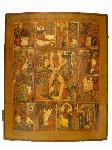
|
| : 22000 |
ID: 5234 | |
 |
| |
Icon “RIGHTEOUS SIMEON OF VERKHOTURYE”, Russia
“RIGHTEOUS SIMEON OF VERKHOTURYE”, end of 19th century, (Ural, Verkhoturye?), wood-panel, grafija, tsekanka on levkas, silver, tempera, 26,6x22,2x2 cm
Saint Simeon of Verkhoturye was a nobleman, but he concealed his origin and led the life of a beggar. He walked through the villages and for free sewed half-coats and other clothes, primarily for the poor. The ascetic wandered much, but most often he lived at a churchyard of the village of Merkushinsk. St Simeon of Verkhoturye died in 1642, when he was 35 years of age. St Simeon worked many miracles after his death. He frequently appeared to the sick in dreams and healed them. A peculiarity of the saint's appearances was that with the healing of bodily infirmities, he also gave instruction and guidance for the soul.
|

|
| : 15000 |
ID: 5231 | |
 |
| |
Icon "DO NOT MOURN FOR ME MOTHER", Russia
"DO NOT MOURN FOR ME MOTHER", the 18/19th century, wood (linden?), gesso, tempera. North Russian school (old-believers)? Icon is in very good condition and has collectible value.755x580x40 mm
The image of “Do not mourn for me Mother” portrays the events of Passion Week, described in the Gospels (Matthew, 27.57-61; Mark, 15.42-47; Luke 23.50-56; John, 19,31-42).
After the Crucifixion of Jesus Chris and His Death on the Cross, Christ`s body was taken by the disciples Nicodemus and the noble Joseph of Arimathaea, wrapped in linen with fragrance, and placed “in the grave”-a cave carved out of the rock face. Although the evangelical texts do not tell of the Virgin`s presence at the Entombment, in the church tradition she always portrayed at the burial of her Son.
The tragic meaning of the icon is reflected in the canon widely read before the image at matins on Great Saturday before Easter. In the sixth song of the canon, the Virgin says: “I see you, the lover of mankind, dead, reviving the dead, and containg all; my womb hurts fiercely. I would die with you, - she said with purity, - because I can not stand to see you dead and breathless.” This composition of the Entombment depicts only the Mother of God and Christ, called according to the introductory text of the Great Saturday canon “Do not mourn for me, Mother, seeing me in the tomb, for I shall arise and be eternally glorified as God. I shall exalt all who magnify you in faith and in love.
This mourning theme got swing first in Byzantium and oldrussian art. Image of “Do not mourn for me mother" is first used in Novgorod 1380. Probably the image has been formated in free interpretation of three images “The Crucifixion”, “The descent from the cross” and “The Entombment”.
”Основы иконографии древнорусской живописи“ Ю.Г. Бовров, 1995.
The style of painting of this icon is characteristic of Northen Russia school.
The Northern Russian School can be described as a local, provincial, and archaizing school, which is often affected by folk art of the North.
Characteristic to the icons is jewel-like painting in luscious colors with incredible detail. Old icon themes continued to be chosen as subjects, but many painters liked to pick new and obscure subjects for their painting. Painters liked to show off their bravura technique with crowed scenes, fantastic architecture and highly decorated clothing on their figures. This style was most claimed in North Russia.
|
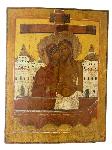
|
| : 200000 |
ID: 4750 | |
 |
| |
Ikoon "Jeesus", Venemaa
"Иесус", конец XIX в. - начало XX в. 260х210.
"Jeesus", XIX sajandi lõpp - XX sajandi algus, 260х210.
|
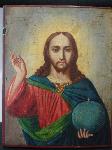
|
| : 3500 |
ID: 1246 | |
 |
| |
|
|
|
 |
 |














